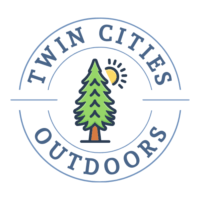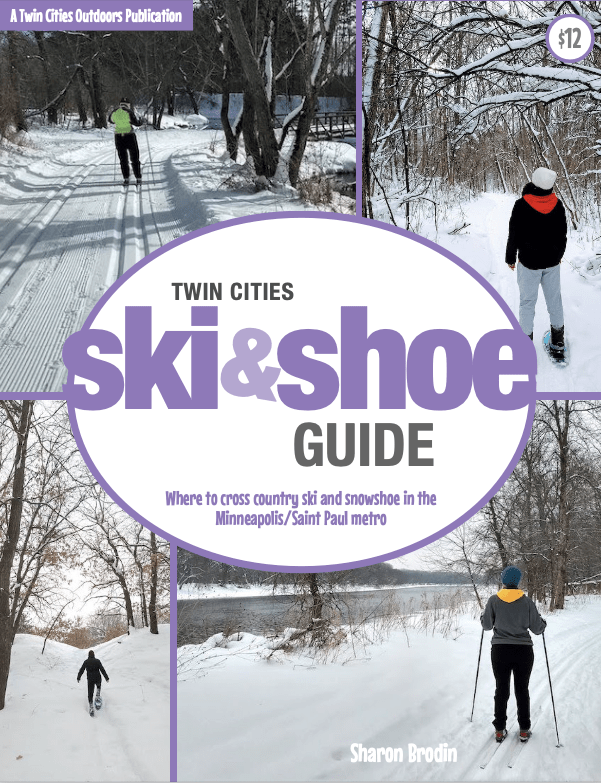So you’re ready to buy a pair of snowshoes to get outside more in our Twin Cities winters. How do you know which ones to choose? We’ll go over some of the basics to help you out.
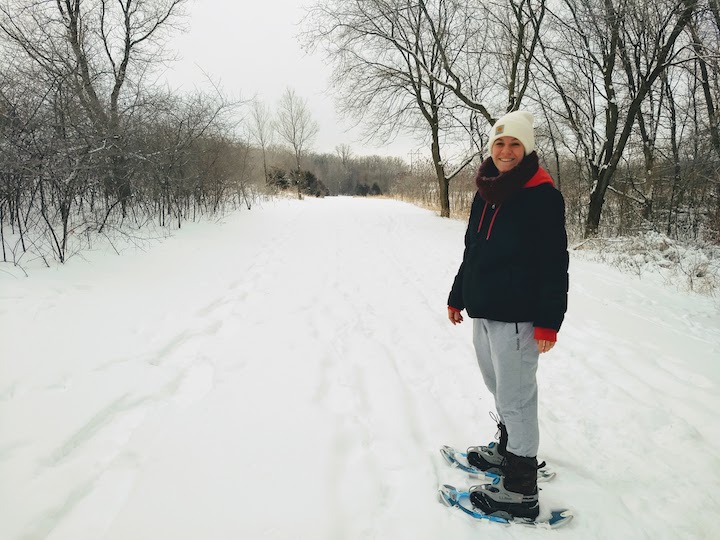
Snowshoeing is growing in popularity for good reason:
- Snowshoeing is super accessible, requiring no special talent or skill.
- Snowshoeing is great exercise that takes advantage of our snowy winters.
- Snowshoeing is very family-friendly, easy for all ages and ability levels.
- You can snowshoe on both designated trails and off-trail, which opens up an entire network of local possibilities.
Two Basic Types of Snowshoes
The two main types of snowshoes are traditional wood-frame snowshoes and modern aluminum/plastic snowshoes.
So your first question might be: Do I prefer a traditional or modern pair of snowshoes?
Traditional wood-frame snowshoes with the criss-crossed webbing are a centuries-old design with, actually, several different styles available. Advantages of this type include:
- They double as very cool outdoor decor when you’re not using them!
- They cover more area, so are better for deep snow than the smaller, modern style.
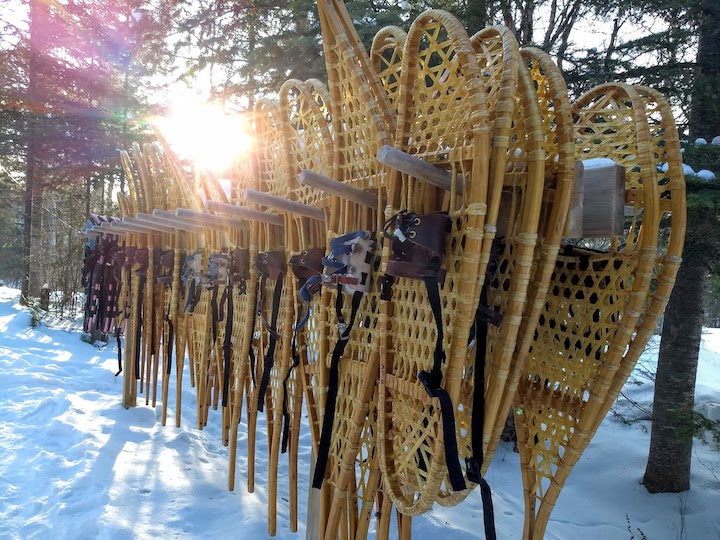
The main disadvantages of this type are:
- They’re bigger and more cumbersome to walk in, especially in the woods if you encounter fallen trees and other obstacles in the trail.
- There’s no built-in traction. That makes them fine for lakes, frozen marsh and other flat conditions, but hills are tricky and they definitely don’t work on ice.
Among wood-framed snowshoes are several different styles. Expect to pay $300 and up for a quality pair of these traditional snowshoes…or buy a kit and make your own for about half that cost! What a fun winter project for the hands-on folks.
Modern metal-framed snowshoes are smaller and easier to walk in. Most are made of aluminum and plastic and include built-in metal crampons for traction, and some kind of adjustable binding system.
Since we don’t get loads of snow in the Twin Cities during most winters, these are generally going to be just fine for most of us—all-purpose snowshoes designed for use on both rolling hills and flat ground.
Snowshoe Brands
As a rule of thumb for outdoor gear for the average person, we suggest going with brands you can find at quality sporting goods stores:
- MSR
- Yukon Charlie’s
- Atlas
- Tubbs
- TSL
- Crescent Moon
- LL Bean makes their own
You may be able to score a used pair at Play It Again Sports, Facebook Marketplace or a garage sale. A friend just told me she picked up a pair of Tubbs at a local Play It Again Sports for under $100, with poles. She did good!
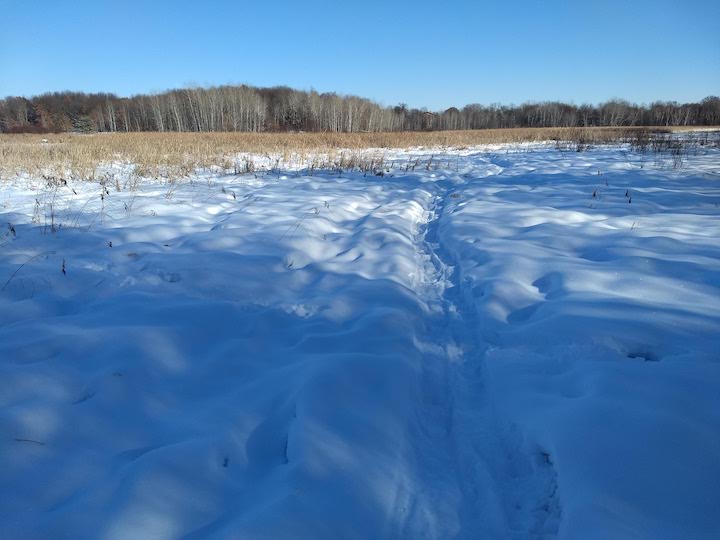
How to Size Snowshoes
While some snowshoes come in unisex models, the main brands make men’s and women’s-specific models. And the difference is in more than just color choices!
Women’s snowshoes are narrower because most women have a narrower stride than men do. For that reason, most women will find snowshoes made for women to be more comfortable for them.
The length of snowshoe you’ll buy depends on your body weight. Standard lengths include:
- 21-inch for 150 pounds and under
- 25-inch for up to 200 pounds
- 30-inch for up to 250 pounds
- 36-inch for up to 300 pounds
Bindings: Quality and Ease of Use
Do yourself a favor and choose snowshoes that have easy-to-use bindings—preferably ones you can adjust and use without taking your gloves off.
Snowshoe bindings are designed to be size-adustable and used with a variety of different boots. The boots I wear snowshoeing depend mostly on the temperature, and then whether I’ll be in fresh snow or on trails.
Waterproof ankle-high hiking boots work great when the temps are milder or if you’ll be on hills and working hard. If we’ve just had several inches of fresh snow and I want to be off-trail in it, I’ll wear my tall snow boots since they keep the snow out better.
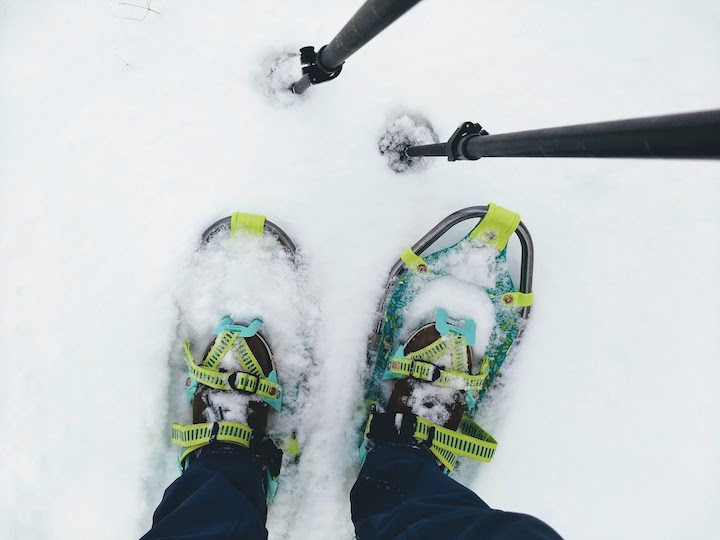
With or Without Trekking Poles?
Some snowshoes come with adjustable trekking poles. Personally, I like using the poles most when I’m doing a lot of hills. They also help with balance if you cross trail obstacles (i.e., fallen trees), go up and down snowbanks, or like taking on steep hills.
I use LL Bean’s Winter Walker snowshoes that came with a carry bag/backpack and collapsible poles. I love having the bag for easy storage of both snowshoes and poles, and for easy transport.
Where to Snowshoe in the Twin Cities
Once we have several inches of snow, there are so many options for snowshoeing in the Twin Cities metro. Really, about the only place you can’t snowshoe is on groomed cross country ski trails.
In my opinion, there’s not much point in snowshoeing on flat, plowed or rolled trails since it’s easier to just wear hiking boots. Snowshoes are great for off-trail in the woods and on designated snowshoe trails where you can find them.
Some of the best places to snowshoe are in singletrack or mountain bike parks. Winter hikers and snowshoers are welcome on almost all of them around the metro area. The only singletrack park that doesn’t allow foot traffic is Battle Creek Regional Park in Ramsey County.
Mountain bike trails are great for snowshoeing because they’re usually hilly and through the woods. You’ll find a variety of trails that twist and turn without a lot of people on them.
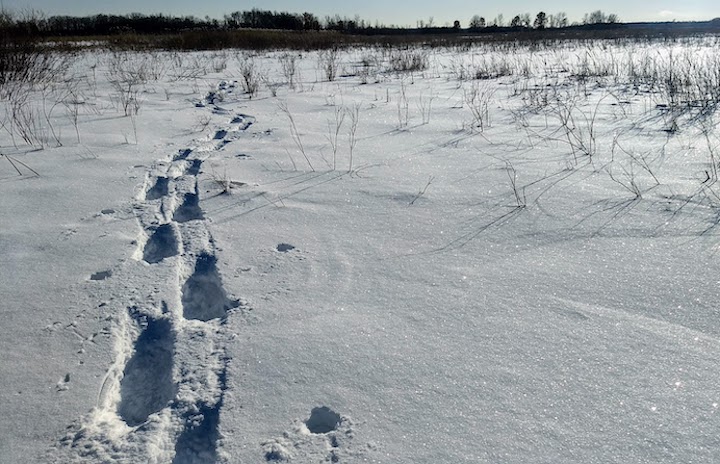
Once the ice is safe for foot traffic, it’s fun to snowshoe on frozen lakes and marshy areas, too. Winter opens those places up to us that aren’t accessible other times of the year.
Twin Cities Ski & Shoe Guide
Published in 2021, our 55-page digital Ski & Shoe Guide is the easiest way to find cross country ski and snowshoe trails in all seven counties of the Twin Cities metro area.
Here’s more…
- Snowshoeing in Elm Creek Park Reserve
- Snowshoeing in Bunker Hills Regional Park
- How to Dress for Below-Zero Weather
- New Winter Gear: How Do These Perform? - November 29, 2023
- Paddle North: SUPs, Kayaks and More - November 20, 2023
- 2023 Holiday Gift Guide for Outdoor Lovers - November 10, 2023
